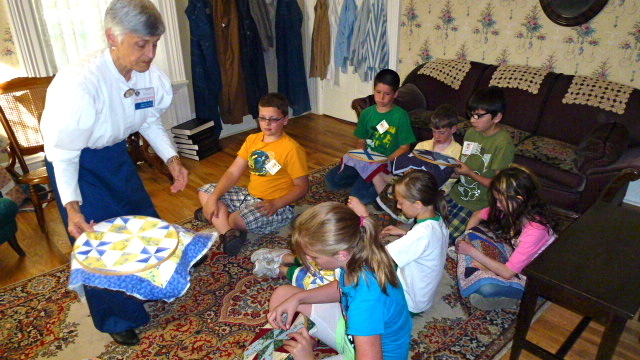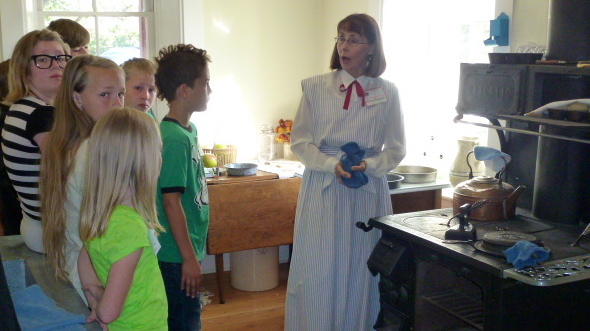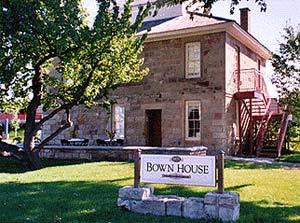Historic timelines of Boise and Idaho have been preserved on the walls of a restored, two-story sandstone pioneer home in East Boise that serves as a museum.
These eloquent timelines deserved more exposure, longtime friends and educators thought, so they orchestrated an idea to put them in every third- and fourth-grade classroom in the Boise School District.
It took thousands of dollars and hundreds of volunteer hours, but now 200 teachers have laminated graphics illustrating the rich history of Boise and Idaho moving from a gold-rush destination to a modern mecca.
“It’s just such a wonderful timeline when you’re standing in the history room of the Bown House,” Juno Van Ocker said. “We wanted to find a way to get it into classrooms.”

Teaching Idaho’s children about how Boise and Idaho were developed is of interest to many, but it’s a passion to Juno Van Ocker and it was a quest for Janet Orndorff.
Orndorff died last month but not before she was instrumental in establishing the Bown House as an historic learning facility, and seeing their timelines be distributed.
The timeline quest began in September. Janet and Juno had just completed one of their special Bown House tours when they dreamed up the idea of getting the timeline on paper and delivered around the city. Just a month later, Janet was diagnosed with breast cancer. It was critical for Juno to continue the work on her own.
“I was so scared,” Juno said. “But I vowed to get it done.”
In January, every elementary school in Boise got a stack of timelines and a lesson plans. Nearly 200 classrooms received more than 3,100 laminated timeline sheets to make learning history more interesting.
“I would encourage teachers who have not yet unpacked their timelines to take a few minutes this summer to get familiar with them and to plan to use them in their classes next year,” teacher Peggy Hurd said. “It will make a world of difference in how kids see their Idaho history studies.”
Marsha Bravo at Lowell Elementary took full advantage of the timelines during her school’s 100th anniversary celebration. She had her students create a timeline of their own life, after studying the state’s timeline.
The timelines

Janet and Juno won a $5,000 grant from the city of Boise’s arts and history department in celebration for the 150 Sesquicentennial, the platting of Boise City in 1863.
They used some of the money to create 18 laminated timeline pages from 1805 to 2013, each depicting events that fourth-graders learn as they study Idaho history. The rest of the money was used to create another 16 laminated timeline pages from 1832 to 2013, given to each third-grade teacher in the Boise schools for their study of the city.
The graphics on each page were drawn by Paige Van Ocker, a 2012 Boise High School graduate and Juno’s oldest granddaughter. It took her most of a month, researching and drawing at least one page a day. The pictures depict Lewis and Clark, the gold rush, telegraphs and transportation. Each was printed and laminated with hundreds of hours of volunteer work.
Two lesson plans for each grade were included with each timeline set. Plans were prepared by Liz Parsons, a third-grade teacher at Riverside Elementary, and Hurd, a fourth-grade teacher at Owyhee Elementary. Hurd put the timelines on a software program, making them available for anyone to download and use.
“I am surprised it took so long for someone to think of it,” Hurd said. “The study of Idaho is difficult for children to grasp. They have no idea about time and progress. Having something that we can refer to on a regular basis has been a boon to our study of Idaho. The kids have gotten so that they refer back to it in our class discussions. It has been great.”
The volunteers also made bookmarks for each third- and fourth-grader in Boise schools.
The Bown House
This rundown house was to be torn down in the early 1990s so the district could build an elementary school.
Orndorff, a School Board trustee, saw value in saving the six-room home, built along the Oregon Trail in 1879 by Joseph and Temperance Bown.
“At the time it was built, it was the fanciest home in the area,” Van Ocker said.

Today, the Bown House tour is part of the district’s Idaho history fourth-grade curriculum. Each year, more than 2,000 fourth-graders walk through a two-hour tour of the home and engage in hands-on activities reflecting the times. They study in an old schoolroom, churn butter, quilt a square, dress up in period clothing and play some of the games pioneer children enjoyed.
Docents, dressed in period clothing, instruct the students and other visitors about life — and survival — in the late 1800s.
“Students come away with a better appreciation and understanding of how life was for Idaho’s early pioneers,” Van Ocker said.
Free public tours of the Bown House are held the first Saturday of each month from 1 to 4 p.m.
“We also have classes from Twin Falls, Idaho Falls and Pocatello visit us,” Juno said.
Joseph Bown came west to find gold. When that didn’t work out, he started to farm 240 acres available for free along the Boise River; the area stretched from the current Barber Park to what is now Boise State University. He and Temperence had seven children. Juno sends yearly newsletters to 33 Bown descendents; some still live in the area.
The house fell into disrepair before it was put on the national historical register in 1979, when it turned 100 years old.
“It was just an old house,” Juno said. “A lot of volunteers and grants from the preservation community saved it.”
Several teachers took a room and wrote up lesson plans and in 1995 the first tours began, hosted by the Assistance League of Boise. The women of the ALB formed the History in the Bown House committee. They have given many hours volunteering at the Bown House and with the timelines.
“Having something that looks so professional and has great usage potential is just a wonderful thing to have,” Hurd said about the timelines.
